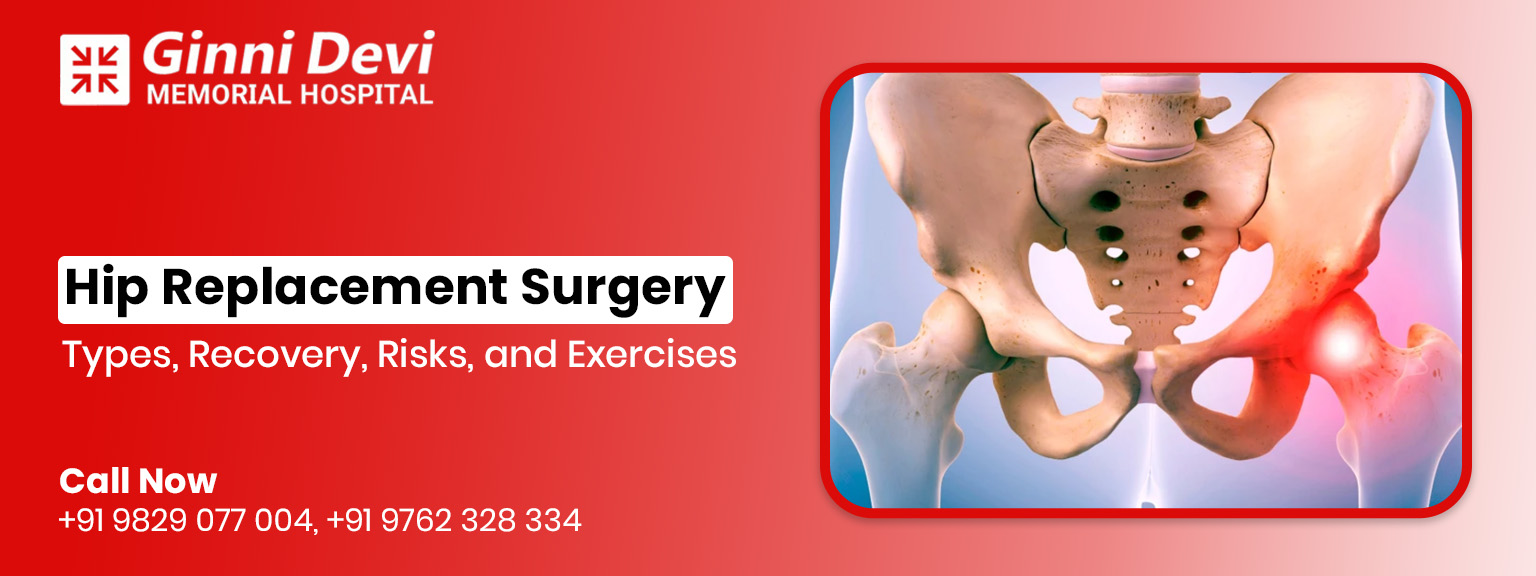If walking is a chore, sitting is uncomfortable, or your hip pain keeps you up at night, these are all signals from your joint for help.
Hip pain can rob you of life’s simple pleasures like walking in the park, playing with the kids, or anything. But the good news? You don’t have to live like this. Today, with the advances in modern medicine, hip replacement is now safer, more rapid, and more effective than ever.
At Ginni Devi Memorial Hospital, a top Orthopedic hospital in Jaipur, our goal is simple: to restore life so that all our patients can get back to their lives, free of pain, fully mobile, and with full confidence in our treatment and surgical care. We will guide you through everything you need to know, such as what hip surgery is, hip replacement surgery types, what recovery looks like, its risks, and the best exercises to get your strength back.
What is hip replacement surgery?
Hip replacement surgery requires your doctor to remove the parts of your hip joint that are damaged and to replace them with artificial parts (prosthetics). It can get you out of pain, help you move better, and bring your body back to normal function, particularly when arthritis or injury makes daily movement challenging.
This is the process for:
- Osteoarthritis
- Rheumatoid arthritis
- Hip fractures
- Bone tumors
- Joint damage due to ageing.
What are the types of hip replacement surgery?
All hips do not require the same kind of repair. Your orthopedic surgeon will suggest the most appropriate choice for you depending on your age, bone health, the level of joint damage, and your lifestyle.
-
Total Hip Replacement (THR)
This is commonly done. In this, the ball (femoral head) as well as the socket (acetabulum) are replaced with artificial implants such as metal and plastic parts. It provides long-term relief for advanced arthritis or joint damage.
-
Partial Hip Replacement
In this type of hip replacement surgery, the ball part of the joint, known as the femoral head, is the only part that is replaced. It is generally advised to do this in elderly patients following some hip fractures.
-
Hip Resurfacing
In this type of hip replacement surgery, the head of the femur is not cut but covered with a smooth metal cap. Appropriate for younger, more active patients with good bone stock.
-
Minimally Invasive Hip Replacement
It is one of the most common hip replacement surgery types, in which the same effect as a total hip replacement is done, but through smaller cuts, and the results are quicker healing, less pain, and minimal blood loss.
What are the risks involved?
After understanding the hip replacement surgery types, the success rate for hip replacement surgery is relatively high; however, like any surgical operation, the procedure can involve several risks, including:
- Wound and joint infection
- Blood clots in your leg (deep vein thrombosis)
- Displacement of the prosthesis
- Loosening or wear of the implant over time
- Nerve damage.
This is the common risk, but with proper surgical techniques, infection control, expert operative care, and choosing a leading hospital like Ginni Devi Memorial Hospital Orthopedic Hospital in Jaipur, prioritise your safety first and be with you at every step.
The Recovery Timeline—What to Expect
Healing after a hip replacement isn’t overnight, but it’s certainly worth the journey.
Week 1–2:
- Pain is managed with medication.
- You’ll begin walking with the help of a walker or crutches.
- Light physical therapy begins right in the hospital.
Weeks 3–6:
- Your movements become more natural.
- Walking and light daily activities resume.
- You’ll do exercises to improve balance, strength, and flexibility.
After 6 Weeks:
- Most patients start walking without support.
- Swelling and stiffness are significantly reduced.
- You can begin enjoying a more active lifestyle again.
Common Exercises After Hip Replacement
- Ankle Pumps: pushing up and down to help with swelling.
- Heel Slides: Lying on back, slide heel toward buttocks.
- Leg Raises: Lift one leg in a straight form.
- Knee Bends: Gently bend and straighten your knee.
- Seated Marching: While sitting, lift your knees one at a time.
- Standing Hip Abduction: From a sitting position, lift one knee at a time.
- Quadriceps Sets: Stand and slide your leg sideways.
Take Your First Step Towards a Pain-Free Life
Don’t let your pain control your life, and take control into your hands. Make an appointment with Ginni Devi Memorial Hospital, where you can find the best Hip replacement surgeon in Jaipur with years of experience and expertise in every field.




